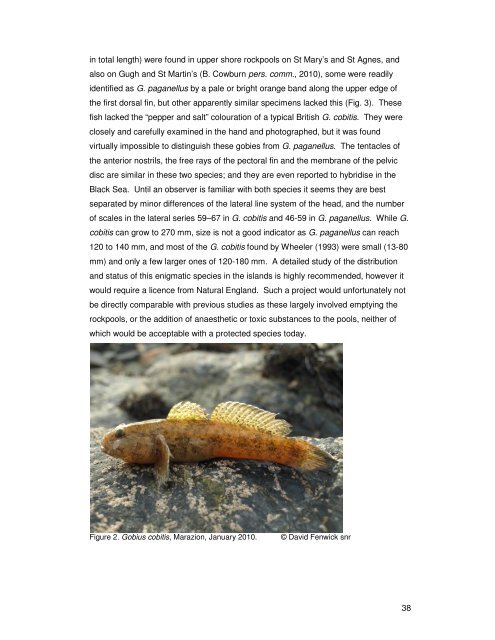Isles of Scilly Fish and Fisheries - Cornwall Wildlife Trust
Isles of Scilly Fish and Fisheries - Cornwall Wildlife Trust
Isles of Scilly Fish and Fisheries - Cornwall Wildlife Trust
You also want an ePaper? Increase the reach of your titles
YUMPU automatically turns print PDFs into web optimized ePapers that Google loves.
in total length) were found in upper shore rockpools on St Mary’s <strong>and</strong> St Agnes, <strong>and</strong><br />
also on Gugh <strong>and</strong> St Martin’s (B. Cowburn pers. comm., 2010), some were readily<br />
identified as G. paganellus by a pale or bright orange b<strong>and</strong> along the upper edge <strong>of</strong><br />
the first dorsal fin, but other apparently similar specimens lacked this (Fig. 3). These<br />
fish lacked the “pepper <strong>and</strong> salt” colouration <strong>of</strong> a typical British G. cobitis. They were<br />
closely <strong>and</strong> carefully examined in the h<strong>and</strong> <strong>and</strong> photographed, but it was found<br />
virtually impossible to distinguish these gobies from G. paganellus. The tentacles <strong>of</strong><br />
the anterior nostrils, the free rays <strong>of</strong> the pectoral fin <strong>and</strong> the membrane <strong>of</strong> the pelvic<br />
disc are similar in these two species; <strong>and</strong> they are even reported to hybridise in the<br />
Black Sea. Until an observer is familiar with both species it seems they are best<br />
separated by minor differences <strong>of</strong> the lateral line system <strong>of</strong> the head, <strong>and</strong> the number<br />
<strong>of</strong> scales in the lateral series 59–67 in G. cobitis <strong>and</strong> 46-59 in G. paganellus. While G.<br />
cobitis can grow to 270 mm, size is not a good indicator as G. paganellus can reach<br />
120 to 140 mm, <strong>and</strong> most <strong>of</strong> the G. cobitis found by Wheeler (1993) were small (13-80<br />
mm) <strong>and</strong> only a few larger ones <strong>of</strong> 120-180 mm. A detailed study <strong>of</strong> the distribution<br />
<strong>and</strong> status <strong>of</strong> this enigmatic species in the isl<strong>and</strong>s is highly recommended, however it<br />
would require a licence from Natural Engl<strong>and</strong>. Such a project would unfortunately not<br />
be directly comparable with previous studies as these largely involved emptying the<br />
rockpools, or the addition <strong>of</strong> anaesthetic or toxic substances to the pools, neither <strong>of</strong><br />
which would be acceptable with a protected species today.<br />
Figure 2. Gobius cobitis, Marazion, January 2010.<br />
© David Fenwick snr<br />
38

















